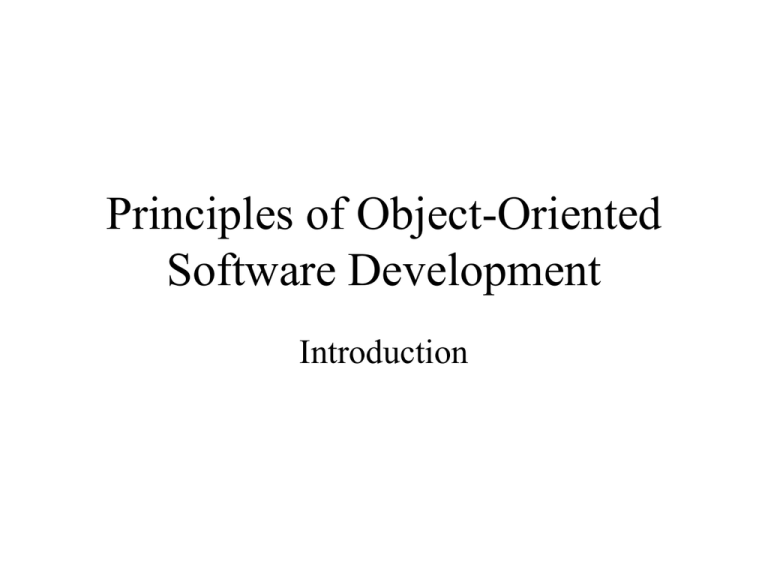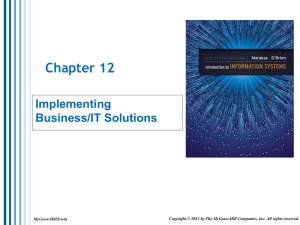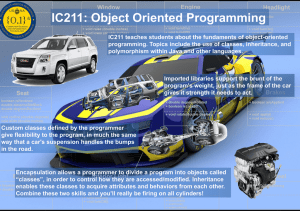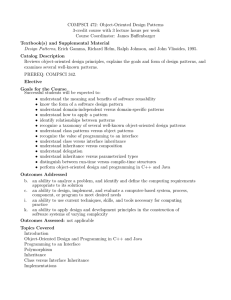Principles of Object-Oriented Software Development Introduction
advertisement

Principles of Object-Oriented
Software Development
Introduction
Introduction
Introduction
Themes and variations
Paradigms of programming
The object-oriented software life-cycle
Trends and technologies
Summary
Q/A
Literature
Themes and Variations
Subsections:
Object Terminology
Object Computation
Design by Contract
Themes and Variations
•
•
•
•
•
abstraction -- the object metaphor
modeling -- understanding structure and behavior
software architecture -- mastering complexity
frameworks -- patterns for problem solving
components -- scalable software
Object Terminology
•
•
•
•
•
•
•
•
•
objects -- packet containing data and procedures
methods -- deliver service
message -- request to execute a method
class -- template for creating objects
instance -- an object that belongs to a class
encapsulation -- information hiding by objects
inheritance -- allowing the reuse of class spec.s class
hierarchy -- tree structure inheritance relations
polymorphism -- to hide different implementations
Features of OOP
• information hiding: state, autonomous behavior
• data abstraction: emphasis on what rather than
how
• dynamic binding: binding at runtime,
polymorphism , virtual functions
• inheritance: incremental changes
(specialization), reusability
Benefits of OOP
• OO = encapsulation + inheritance
• modularity -- autonomous entities, cooperation
through exchanges of messages
• deferred commitment -- the internal workings of an
object can be redefined without changing other
parts of the system
• reusability -- refining classes through inheritance
• naturalness -- object-oriented analysis/design,
modeling
Object Computation
The object model
computation is sending
messages between objects
Message
object method arguments
Computing Devices
mathematical model -- Turing machine
universal machine -- machines as programs
computability & complexity -- time/space bounded
Object-oriented programming does not enlarge
the class of computable problems, nor does it reduce
the computational complexity of the problems we can handle.
Design by Contract
Abstract Data Types
ADT = state + behavior
Object-Oriented Modeling
data oriented
Responsibilities
what rather than how
to specify behavior
Client
makes request to perform a service
Server
provides service upon request
client/server model
object = information + responsibilities
Contracts
a set of services
Behavioral refinement
improving contracts
Conformance --
behavioral refinement
if B refines A then B may be
used wherever A is allowed
Attributes
more information
Services
better services
Contracts
more and better services
A better service
fewer restrictions for the client
more obligations for the server
refine
Object-Oriented Modeling
prototyping, specification, refinement, interactions
OOP = Contracts + Refinements
Paradigms of programming
Subsections:
Procedural programming
Data abstraction
Object-oriented programming
Object-Oriented Programming
high tech synonym for good
Styles of programming
A language supports a style of programming if it provides
facilities that make it convenient (easy, safe and
efficient) to use that style
compile/runtime checks
clean interpretation/
orthogonal / efficient / minimal
Paradigms of Programming
Procedural programming
procedures, use the optimal algorithms
Modules
hide the data, provide functional abstractions
Data abstraction
types, provide a sufficientlycomplete set of operations
Object-oriented programming
-- organize your types
make commonality explicit by using inheritance
Procedural programming
while ( programming == art ) {
incr( pleasure );
decr( bugs );
incr( portability );
incr( maintainability );
incr( quality );
incr( salary );
} // live happily ever after
Data abstraction
Support for data abstraction
Abstract Data Types -- encapsulation
Encapsulation
initialization
protection
coercions
Object-oriented programming
Support for OOP
Polymorphism -- inheritance
Inheritance
dynamic binding
protection
multiple inheritance
The object-oriented
software life-cycle
Subsections:
Analysis
Design
Implementation
The software life-cycle
• Analysis -- Conceptual Model, System
Requirements
• Design -- System Design, Detailed Design
• Implementation -- Coding, Testing
With an increase in the number of software products not
satisfying user needs, prototyping has become quite popular!
Requirements -- user needs are
constantly evolving
• Reliability -- incremental development,
reuse, synthesis
• Adaptability -- evolutionary prototyping
• Maintainability -- incremental development,
synthesis
• Performance -- incremental development,
reuse
Software Development Models
•
•
•
•
•
rapid throwaway prototyping -- quick and dirty
incremental development -- slowly evolving
evolutionary prototyping -- evolving requirements
reusable software -- reduces cost and time
automated software synthesis -- one level of
abstraction higher
Analysis
Object Oriented Analysis
analysis = extracting the needs
The problem domain -- complex reality
Communication -- with domain experts
Continual change -- user requirements
Reuse -- of analysis results
Analysis Methods
• Functional Decomposition = Functions + Interfaces
• Data Flow Approach = Data Flow + Bubbles
• Information Modeling = Entities + Attributes +
Relationships
• Object-Oriented = Objects + Inheritance + Message
passing
Design
Object-Oriented Design
design for maintenance and reuse!
Software quality
correctness, robustness, extensibility, compatibility
Design Projects
IDA -- Interior Design Assistant
MASS -- Multi-user Agenda Support System
Design assignments
IDA
An Interior Design Assistant (IDA) is a tool to support an
interior design architect. When designing the interior of a house
or building, the architect proceeds from the spatial layout and a
list of furniture items. IDA must allow for placing placing
furniture in a room. It will check for constraints. For example
placing a chair upon a table will be prohibited. For each design,
IDA must be able to give information with respect to
pricing and the time it takes to have the furniture items
delivered. In addition to the design facilities, IDA must also
offer a showroom mode, in which the various designs can be
inspected and compared with respect to price and delivery time.
MASS
An Agenda Support System assists the user in maintaining a
record of important events, dates and appointments. It moreover
offers the user various ways of inspecting his or her agenda, by
giving an overview of important dates, an indication of
important dates on a calendar, and (more advanced) timely
notification.
...
A Multi-user Agenda Support System extends a simple
Agenda Support System by providing facilities for scheduling
a meeting, taking into account various constraints imposed
by the agendas of the participants, as for example a special
event for which a participant already has an entry in his or her
agenda. A minimal Multi-user Agenda Support System must
provide facilities for registering important dates for an arbitrary
number of users. It must, moreover, be able to give an overview
of important dates for any individual user, and it must be
possible to schedule a meeting between an arbitrary subset of
users that satisfies the time-constraints for each individual in that
particular group. This minimal specification may be extended
with input facilities, gadgets for presenting overviews and
the possibility of adding additional constraints. Nevertheless, as
an advice, when developing a Multi-user Agenda Support
System, follow the KISS principle: Keep It Simple ...
Implementation
Errors, bugs
•
•
•
•
•
•
•
•
•
TeX
[A] -- algorithm awry
[B] -- blunder
[C] -- structure debacle
[F] -- forgotten function
[L] -- language liability
[M] -- mismatch between modules
[R] -- reinforcement of robustness
[S] -- surprises
[T] -- a trivial typo
Smalltalk -- a radical change in programming languages
rapid prototyping
Eiffel -- a language with assertions
correctness
C++ -- is much more than a better C
the benefits of efficiency
Java -- the dial-tone of the Internet
security
DLP -- introduces logic into object orientation
development of knowledge-based systems
Beyond Object-Orientation?
Trends -- modeling
patterns -- examples of design
UML -- Unified Modeling Language
Technologies -- components
Web -- global infrastructure
CORBA/DCOM - the software bus
Java -- the platform?
Challenges
Applications -> Frameworks <- Patterns
Challenges in O-O
• vertical framework development -- finance, medical
care, insurance
• separation of 'logic' from 'control' -- business rules
• distributed object technology -- heterogeneous
systems
• visualisation -- structure and processes
• knowledge intensive applications -- declarative
• heterogeneous systems - fragmented applications
Summary
1
Themes and Variations
• terminology -- all phrases
• object computation -- message passing
• contracts -- for constructing and validating
software
2
Paradigms of
programming
• styles of programming -- as a family of
conventions
• data abstraction -- and its possible
realizations
• polymorphism -- and the features of
inheritance
3
The object-oriented
software life-cycle
• software development models -- in
particular the role of prototyping
• software quality -- in relation to reuse and
maintenance
• programming languages -- the choice of a
vehicle
4
Beyond object-orientation?
• modeling -- patterns, UML
• components -- CORBA, (D)COM, Java
• heterogeneous systems -- separating logic
and control
Questions
1.How would you characterize OOP and what, in your opinion, is the
motivation underlying the introduction of OOP?
2.Characterize the most important features of OOP.
3.Explain the meaning of the phrase "object orientation reduces the
complexity of programming."
4.How would you characterize contracts? Why are contracts important?
5.How is OOP related to programming languages?
6.What classes of languages support OOP features? Explain.
7.What influence is an object-oriented approach said to have on the
software life-cycle? What is your own opinion? Discuss the problem of
maintenance.
8.How would you characterize software quality?
9.Mention a number of object-oriented programming languages, and give
a brief characterization.
10.What do you see as the major challenges for research in objectorientation?
Nowadays there are many books that may serve as a starting point
for reading about OO. Dependent on your interest, you may look at
[Surviving], which treats issues of OO project management,
[Meyer97], which gives an extensive introduction to design by
contract and programming in Eiffel, or [Fowler97], which gives a
succinct introduction to UML. Alternatively, you may take one of
the introductory programming books for Java, from which you will
almost certainly learn something about OO as well.
Further reading
Nowadays there are many books that may serve as a starting point
for reading about OO. Dependent on your interest, you may look at
[Surviving], which treats issues of OO project management,
[Meyer97], which gives an extensive introduction to design by
contract and programming in Eiffel, or [Fowler97], which gives a
succinct introduction to UML. Alternatively, you may take one of
the introductory programming books for Java, from which you will
almost certainly learn something about OO as well.




